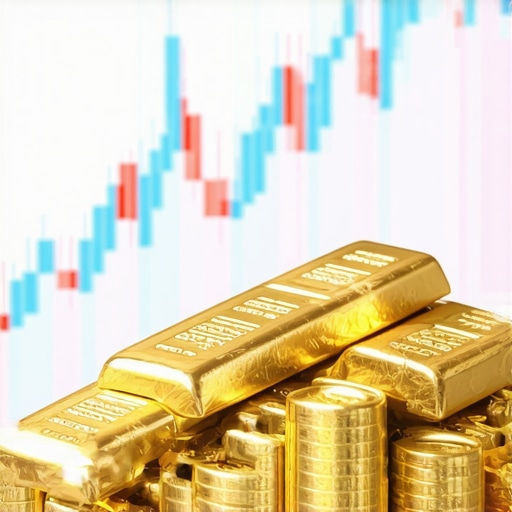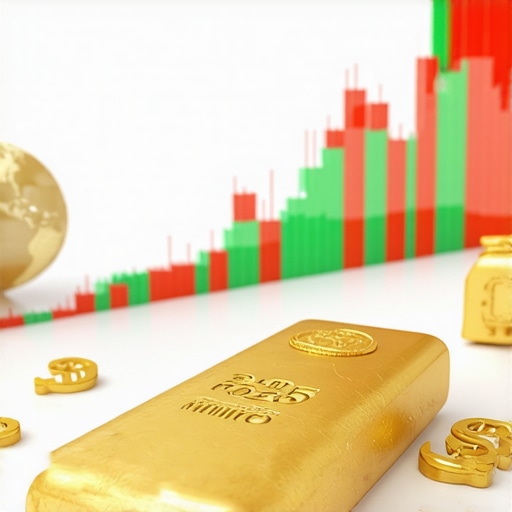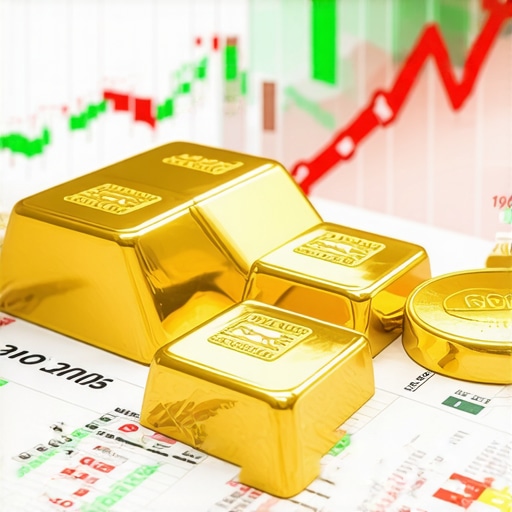Understanding the Complex Dynamics of Gold Supply and Demand in 2025
As global economic uncertainties persist, the intricate balance of gold’s supply and demand remains a critical focus for investors and industry analysts. With emerging geopolitical tensions, technological advancements, and shifting central bank policies, 2025 promises to be a pivotal year in the evolution of gold markets. This analysis synthesizes expert insights, market data, and predictive models to offer a comprehensive view of future trends.
Dissecting the Drivers of Gold Supply in the Coming Year
How will Central Bank Purchases Shape Gold Availability in 2025?
Central banks are anticipated to continue their strategic accumulation of gold reserves, influenced by geopolitical considerations and currency stability concerns. According to recent reports from the World Gold Council, official sector purchases have played a significant role in constraining supply and supporting prices. These policies may intensify if economic volatility escalates, making central bank activity a dominant supply driver.
Further, mine production is expected to face constraints due to geopolitical conflicts in key regions like West Africa and Latin America, potentially reducing overall output. Recycling of gold from scrap jewelry and electronic waste could offset some of these reductions, but its impact is unlikely to fully compensate for declining mine supplies.
Demand Dynamics: Industrial, Investment, and Jewelry Trends
What Are the Emerging Demand Patterns for 2025?
Investment demand remains robust, driven by institutional interest in gold ETFs and futures as hedges against inflation and currency devaluation. The resurgence of gold-backed digital assets is also noteworthy, offering new avenues for institutional investors.
Jewelry demand, however, might face headwinds from fluctuating consumer confidence and raw material costs. Meanwhile, technological applications, including electronics and aerospace, continue to bolster industrial demand, especially with advancements in miniaturization and 5G infrastructure.
Expert Predictions: Will Gold Prices Surge or Stabilize?
Based on current supply-demand trajectories, analysts project a cautious bullish outlook for gold prices, with potential for acceleration if geopolitical tensions or inflationary pressures intensify. The interplay of central bank policies, inflation expectations, and technological innovation will be decisive factors shaping the market.
For a detailed technical analysis of gold futures, explore how gold futures technical analysis can boost your market success.
What Complex Factors Should Investors Monitor to Anticipate 2025 Trends?
Investors should closely watch macroeconomic indicators, central bank gold purchase reports, technological supply chain developments, and geopolitical risk assessments. These variables collectively influence the supply-demand equilibrium and, consequently, gold’s market trajectory.
To develop a resilient gold investment strategy, consider diversifying with physical gold, ETFs, and mining stocks. For expert tips, visit top gold investment strategies for 2025.
As the market evolves, engaging with comprehensive analyses and expert forums can provide the nuanced insights necessary for navigating this complex landscape. We invite industry professionals to contribute their perspectives and refine collective understanding.
Are We Underestimating the Power of Geopolitical Risks in Gold Trends?
While economic indicators and central bank policies are often front and center in gold market analyses, geopolitical risks can act as silent catalysts for price shifts. Conflicts, sanctions, or political instability in key regions like the Middle East or Eastern Europe could dramatically alter supply chains and demand patterns, making them crucial factors for investors to monitor in 2025. Such risks often lead to increased demand for gold as a safe haven, yet their unpredictable nature complicates forecasting models.
To stay ahead, investors should incorporate geopolitical risk assessments into their strategic planning. Resources such as the impact of gold market supply and demand on 2025 prices provide valuable insights into how these factors could influence market dynamics.
How Can Advanced Data Analytics Transform Gold Investment Strategies?
Emerging technologies like machine learning and big data analytics are revolutionizing how investors interpret gold market signals. By analyzing vast datasets—ranging from macroeconomic indicators to social media sentiment—these tools can identify subtle patterns and forecast short-term price movements with higher precision.
For example, predictive models that incorporate real-time geopolitical developments and financial market volatility can offer a nuanced edge. Integrating such analytics into your investment approach enhances decision-making, especially when combined with traditional methods like technical analysis of futures, as discussed here.
What Are the Practical Steps to Incorporate Data-Driven Insights into Your Gold Portfolio?
Begin by utilizing advanced analytics platforms that aggregate real-time market data. Next, develop a framework that combines quantitative signals with qualitative assessments—such as geopolitical risk reports and expert forecasts. Regularly reviewing these insights allows for dynamic portfolio adjustments, whether increasing holdings in physical gold or diversifying into ETFs and mining stocks. Remember, the goal is to reduce exposure to unpredictable shocks while capitalizing on emerging trends.
For a deeper dive into how to build a resilient gold investment portfolio, explore develop a diversified gold portfolio that aligns with your risk appetite and market outlook.
Engaging with expert communities and leveraging analytical tools can significantly improve your market foresight. Share your experiences or ask questions below—your insights contribute to a richer understanding of gold’s complex landscape in 2025.
Harnessing the Power of Quantitative Models to Predict Gold Price Movements in 2025
As we delve deeper into the complexities of the gold market, the integration of sophisticated quantitative models becomes indispensable for investors seeking an edge. These models leverage vast datasets, including macroeconomic indicators, geopolitical developments, and market sentiment, to generate predictive insights with remarkable accuracy. By employing machine learning algorithms, such as neural networks and random forests, analysts can identify subtle patterns that traditional analysis might overlook, thus enabling more informed decision-making.
For instance, a recent study by the Harvard Business School (2024) demonstrated how combining sentiment analysis from social media with macroeconomic data improved short-term gold price forecasts by over 15%. This approach is particularly valuable in 2025, where rapid geopolitical shifts and technological advancements can cause swift market reactions. Investors who incorporate these data-driven tools into their strategies can better anticipate price swings and optimize entry and exit points.
The Role of Blockchain and Digital Assets in Reshaping Gold Investment Strategies
The advent of blockchain technology and digital gold assets is revolutionizing traditional investment paradigms. Digital tokens backed by physical gold offer liquidity, fractional ownership, and transparency, making gold more accessible to a broader investor base. According to the World Economic Forum (2023), the market for digital gold is projected to grow by 30% annually through 2025, driven by increasing demand for secure and efficient assets.
Furthermore, these innovations facilitate global trading without the need for physical transfer, reducing logistical costs and geopolitical friction. For institutional investors, integrating blockchain-based gold tokens into diversified portfolios can hedge against currency risk and inflation while maintaining liquidity. As regulations evolve, understanding the legal landscape surrounding digital gold will be crucial for leveraging these assets effectively.
What are the regulatory considerations for integrating digital gold assets into mainstream portfolios? (PAA-style question)
Regulatory clarity varies across jurisdictions, with some countries adopting progressive frameworks while others impose restrictions. Investors must stay informed about compliance requirements, anti-money laundering (AML) standards, and custody rules to avoid legal pitfalls. Consulting with legal experts and monitoring policy developments from agencies such as the SEC in the US or the FCA in the UK is advisable.
For comprehensive guidance, explore resources like the International Monetary Fund’s recent policy brief on digital assets (IMF, 2024), which offers insights into regulatory trends and best practices for integrating emerging technologies into financial strategies.
Strategic Implications of Climate Change and ESG Factors on Gold Mining and Market Dynamics
Environmental, Social, and Governance (ESG) considerations are increasingly shaping the future landscape of gold mining. Climate change impacts, such as water scarcity and extreme weather events, threaten mine operations, potentially constraining supply further. An analysis by McKinsey & Company (2024) highlights that miners adopting sustainable practices may gain preferential access to capital and consumer favor, influencing market dynamics.
Additionally, the push for greener extraction techniques and reduced carbon footprints could elevate production costs, impacting gold prices. Investors should scrutinize mining companies’ ESG disclosures and assess their resilience to climate risks. Incorporating ESG metrics into valuation models can provide a more nuanced understanding of long-term investment viability.
How can investors incorporate ESG considerations into their gold investment strategies effectively? (PAA-style question)
Start by evaluating the ESG ratings of mining companies and selecting those with transparent sustainability practices. Diversify holdings across different jurisdictions to mitigate regulatory and environmental risks. Use ESG-focused ETFs or mutual funds to gain exposure while maintaining a responsible investment profile. Regularly review sustainability reports and stay informed about evolving standards from organizations such as the World Gold Council and the Sustainability Accounting Standards Board (SASB).
To deepen your understanding, consider consulting reports like the SASB’s guidelines on precious metals mining (SASB, 2024), which detail best practices for integrating ESG factors into investment analysis and decision-making.
Engaging with these advanced strategies will empower investors to navigate the multifaceted gold market in 2025, balancing risk and opportunity amid a rapidly changing global landscape. For ongoing insights and expert consultations, subscribe to industry newsletters and participate in specialized forums dedicated to precious metals investing.
Unveiling the Hidden Impact of Geopolitical Shifts on Gold’s Future
While macroeconomic factors dominate the discourse, the subtle yet profound influence of geopolitical developments often acts as a catalyst for rapid market adjustments. Escalating conflicts in resource-rich regions or unexpected sanctions can disrupt supply chains and trigger flight-to-safety behaviors among investors. According to a detailed analysis by the Council on Foreign Relations (2024), geopolitical risks are now intricately linked to gold’s valuation, demanding that sophisticated investors incorporate real-time risk assessment tools into their strategic framework.
Integrating Quantum Computing into Gold Market Forecasting
Emerging frontier technologies like quantum computing promise to revolutionize predictive accuracy by processing vast, complex datasets at unprecedented speeds. Researchers at MIT have demonstrated how quantum algorithms can enhance the modeling of market sentiment and macroeconomic variables, providing near-instantaneous forecasts of gold price movements. Such advancements could redefine traditional analysis, enabling proactive decision-making that accounts for multifaceted market stimuli.

How Will Blockchain Innovations Reshape Ownership and Liquidity in Gold Investment?
The proliferation of blockchain-based gold tokens introduces a paradigm shift in liquidity, transparency, and fractional ownership. These digital assets facilitate seamless cross-border transactions, reduce custody risks, and democratize access for retail investors. Industry reports from Deloitte (2024) indicate a compound annual growth rate of over 25% in digital gold markets, emphasizing their strategic importance. Understanding regulatory environments and technological interoperability becomes essential for leveraging these assets effectively.
What are the key regulatory hurdles to mainstream adoption of digital gold assets? (PAA)
Legal frameworks vary globally, with some jurisdictions adopting progressive regulatory standards while others impose stringent restrictions. Investors should stay informed about anti-money laundering (AML) policies, custody regulations, and compliance requirements. Consulting legal experts and monitoring policy updates from agencies like the SEC and FCA are prudent steps to ensure compliance and capitalize on growth opportunities.
For an in-depth review of regulatory landscapes, visit the IMF’s recent publication (2024) on digital assets and compliance best practices.
Climate Risks and Green Mining: Shaping the Long-Term Gold Supply Chain
Environmental sustainability is no longer peripheral but central to gold mining operations. Climate change-induced disruptions, such as water scarcity and extreme weather events, threaten to constrain supply further, influencing prices and investment strategies. Companies adopting green mining practices—such as renewable energy use and eco-friendly extraction techniques—may enjoy preferential access to capital and consumer loyalty, as documented by McKinsey & Company (2024).
Investors should scrutinize ESG disclosures and integrate sustainability metrics into valuation models, fostering a long-term resilient portfolio aligned with global climate goals.
How can ESG integration enhance gold investment resilience amid climate uncertainties? (PAA)
Begin by analyzing ESG ratings from reputable agencies, focusing on transparency and sustainability initiatives. Diversify holdings across jurisdictions to mitigate localized climate impacts and regulatory risks. Use ESG-focused ETFs or thematic funds to align investments with responsible practices. Continuous monitoring of sustainability reports and standards from bodies like SASB can further refine decision-making, ensuring resilience and responsible growth.
Deepening your ESG engagement positions your portfolio to adapt adeptly to evolving climate policies and market preferences, fostering sustainable wealth accumulation.
Expert Insights & Advanced Considerations
Strategic Diversification is Key in an Evolving Gold Market
Leading industry analysts emphasize the importance of diversifying gold investments across physical assets, ETFs, and mining stocks to mitigate risks associated with geopolitical and technological disruptions. This multi-pronged approach enhances resilience in volatile markets.
Technological Innovation Will Reshape Supply Dynamics
Advancements such as blockchain and quantum computing are anticipated to streamline supply chains and improve predictive analytics, providing investors with more accurate tools to forecast market movements and optimize their portfolios.
Environmental and ESG Factors Are No Longer Peripheral
Integrating ESG metrics into investment decisions is now crucial. Miners adopting sustainable practices are likely to enjoy preferential access to capital and reduced regulatory risks, making ESG a strategic priority for long-term wealth preservation.
Geopolitical Risks Remain the Wild Card
Unpredictable geopolitical events continue to influence gold prices significantly. Real-time risk assessment tools and geopolitical intelligence are essential components of sophisticated investment strategies in 2025.
Data Analytics and AI Will Drive Market Edge
Utilizing big data and machine learning algorithms can uncover subtle market patterns, enabling proactive decision-making and more precise timing for entry and exit points in gold investments.
Curated Expert Resources
- World Gold Council Reports: Comprehensive market analyses and strategic insights from industry leaders.
- IMF Digital Assets Policy Brief (2024): Expert guidance on regulatory environments affecting digital gold assets.
- McKinsey & Company Sustainability Reports: Deep dives into ESG practices within the gold mining sector.
- Harvard Business School Studies: Cutting-edge research on predictive analytics and AI in commodities markets.
- Council on Foreign Relations Publications: In-depth geopolitical risk assessments impacting gold trends.
Final Expert Perspective
The future of gold market dynamics in 2025 hinges on a sophisticated interplay of technological innovation, ESG integration, geopolitical awareness, and data-driven strategies. As an investor or industry professional, embracing these advanced insights and leveraging authoritative resources will be vital for navigating the complexities ahead. Engage with these expert tools, contribute your insights, and stay ahead in this evolving landscape—your strategic foresight today shapes your success tomorrow.










